Search results for: 'Mittelalter'
-
 Islamische Öllampe mit großem Zungenhenkel
Islamische Öllampe mit großem ZungenhenkelSpitzovale Lampe mit doppelkonischem Körper. Auf der Schnauze erhabener Zweig, Schulter verziert.
Price: on request Islamische Öllampe
Islamische ÖllampeSeltenes und interessantes Belegstück aus der Übergangszeit von den byzaninischen zu den islamischen Öllampen.
Price: on request Glasierte persische Öllampe
Glasierte persische ÖllampeMuseumswürdig erhalten. Langgezogene Schnauze, runder Körper mit Kanneluren, Henkel als Lilienblatt geformt mit Dekor.
Price: on request Islamisches Gewicht aus Bronze
Islamisches Gewicht aus BronzeAntikes Scheibengewicht. Interessante Pilzform aus früher, islamischer Zeit. 6. bis 8. Jh. n. Chr. Entsprechend ca. 1/2 Dirhem oder 1/3 Numisma.
Price: on request Islamisches Gewicht mit Markierung
Islamisches Gewicht mit MarkierungDomförmiges Gewicht, wohl aus frühe islamische Zeit. 6. bis 8. Jh. n. Chr. Entsprechend 1 Mithqal. Seitliche Markierung oder Beschriftung.
Price: on request Antike Pfeilspitze aus Eisen
Antike Pfeilspitze aus EisenKleine Pfeilspitze mit quadratischem Querschnitt, sich stark zur Spitze hin verjüngend. 9. - 13. Jh. n. Chr.
Price: on request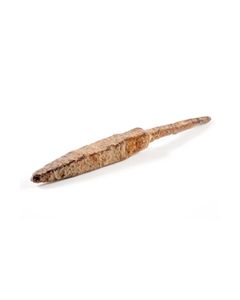 Massive antike Pfeilspitze aus Eisen
Massive antike Pfeilspitze aus EisenQuadratischer Querschnitt, massive Ausführung. Für Alter und Material sehr schwache Korrosion. 9. - 13. Jh. n. Chr.
Price: on request Antike Pfeilspitze aus Eisen
Antike Pfeilspitze aus EisenKleine Pfeilspitze mit quadratischem Querschnitt, sich stark zur Spitze hin verjüngend. 9. - 13. Jh. n. Chr.
Price: on request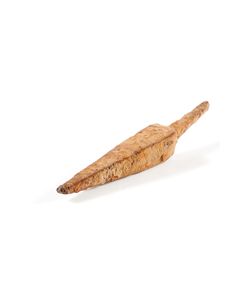 Antike Pfeilspitze aus Eisen
Antike Pfeilspitze aus EisenKleine Pfeilspitze mit quadratischem Querschnitt, sich stark zur Spitze hin verjüngend. 9. - 13. Jh. n. Chr.
Price: on request Massive kleine Kugelflasche
Massive kleine KugelflascheKugelförmiges Fläschchen. Interessanter Typ, abgeschnittener Hals, farbenfrohe Patina.
Price: on request Islamische Öllampe mit großem Zungenhenkel
Islamische Öllampe mit großem ZungenhenkelZwischen Füll- und Brennloch zwei S-Förmige Strukturen. Schulter und Nase mit stilisierten spitzen Blättern.
Price: on request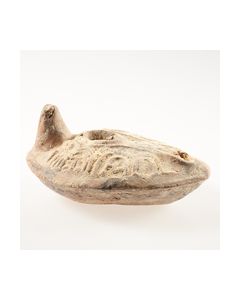 Islamische Öllampe
Islamische ÖllampeZwischen Füll- und Brennloch dreigliedrige Kette mit elliptischen Gliedern. Nase und Schultern verziert.
Price: on request Islamische Öllampe
Islamische ÖllampeAußergewöhnlich koloriertes, museal erhaltenes Stück. Mit Rußspuren und starker Sandpatina.
Price: on request Christliche Öllampe aus islamischer Zeit
Christliche Öllampe aus islamischer ZeitOvale Lampe mit doppelkonischem Körper. Mit hohem Standring, darin ein großes Kreuz.
Price: on request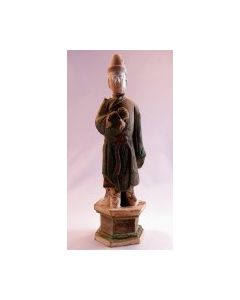 Riesiger Terracotta Diener, Ming-Dynastie
Riesiger Terracotta Diener, Ming-DynastieBeeindruckend große Grabfigur, Altes China, 1368 bis 1644 n.Chr. Originale Bemalung, restauriert.
Price: on request Chinesische Holzbuchstaben in Setzkasten
Chinesische Holzbuchstaben in SetzkastenVollständiger Setzkasten, bestehend aus 486 Einzelbuchstaben. Die Gebrauchsspuren belegen eine rege Nutzung dieses seltenen Belegstücks der asiatischen Buchdruckkunst.
Price: on request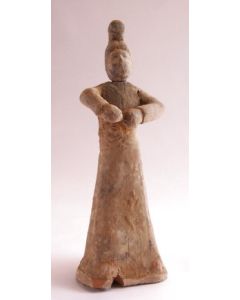 Terracotta Musiker, Tang-Dynastie
Terracotta Musiker, Tang-Dynastie618 bis 907, China. Aus Gruppe von Musikern, Grabbeigabe. Ca. 22cm hoch. Hohl. Kopf und Körper einzeln gebrannt. Kopf wurde restauriert.
Price: on request Terracotta Musiker, Tang-Dynastie
Terracotta Musiker, Tang-Dynastie618 bis 907, China. Aus Gruppe von Musikern, Grabbeigabe. Ca. 22cm hoch. Hohl. Kopf und Körper einzeln gebrannt. Kopf wurde restauriert.
Price: on request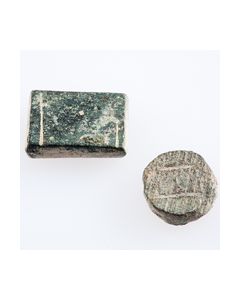 Zwei antike Gewichte aus dem heilgen Land
Zwei antike Gewichte aus dem heilgen LandBronzegewichte, in Plattenform und Scheibenform. 1/4 Schekel und 1/2 Dirhem. Funde aus Israel.
Price: on request Terracotta Tänzerin, Tang-Dynastie
Terracotta Tänzerin, Tang-Dynastie618 bis 907, China. Aus Gruppe von Musikern, Grabbeigabe. Ca. 22cm hoch. Hohl. Kopf und Körper einzeln gebrannt. Kopf wurde restauriert.
Price: on request Terracotta Musiker, Tang-Dynastie
Terracotta Musiker, Tang-Dynastie618 bis 907, China. Aus Gruppe von Musikern, Grabbeigabe. Ca. 22cm hoch. Hohl. Kopf und Körper einzeln gebrannt. Kopf wurde restauriert.
Price: on request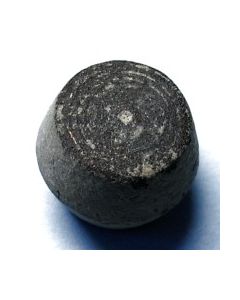 Bronzegewicht, Islamisch, 1/2 Uqiyyah
Bronzegewicht, Islamisch, 1/2 UqiyyahLevante, 6 Jh. n.Chr. bis 10 Jh. n. Chr., spätbyzantinische bis islamische Epoche. Entsprechende antike Gewichtseinheit: 1/2 Uqiyyah (Waqiyyah), oder ca. 3 1/2 Mithqal.
Price: on request Antike Bronzemünze aus Kaschmir
Antike Bronzemünze aus KaschmirIndische Münze aus dem 9. Jahrhundert n. Chr. Vorzüglich erhalten, Durchmesser 19 mm, Gewicht 6,03 Gramm.
Price: on request Antikes Glas mit viereckigem Gefäßkörper
Antikes Glas mit viereckigem GefäßkörperMassives Glasfläschchen, dickwandig. Östlicher Mittelmeerraum. Aus der Zeit der islamsichen Expansion. Ca. 50mm hoch.
Price: on request Glasierte islamische Öllampe
Glasierte islamische ÖllampeMuseal erhalten. Langgezogene Schnauze, runder Körper, durch Steg und Henkel mit diskusförmigem Standfuß verbunden.
Price: on request Feiner islamischer Schmuckanhänger
Feiner islamischer SchmuckanhängerBronzeanhänger für Ohrring oder Kette. 7. bis 13. Jh. n. Chr., islamische Blütezeit der Umayyaden und Abbasiden. Fein gearbeitet, kräftige Fundpatina.
Price: on request Islamischer Schmuckanhänger
Islamischer SchmuckanhängerBronzeanhänger für Ohrring oder Kette. 7. bis 13. Jh. n. Chr., islamische Blütezeit der Umayyaden und Abbasiden. Fast vorzüglich erhalten, sehr schöne dunkle Fundpatina.
Price: on request Tempel-Ölgefäß (D)
Tempel-Ölgefäß (D)Song-Dynastie, Altes China, 960 bis 1279 n.Chr. Keramik mit brauner Glasur. Für Öl. Sehr gut erhalten.
Price: on request Cicero - very rare German 1535 edition with 234 partially page-large woodcuts
Cicero - very rare German 1535 edition with 234 partially page-large woodcutsThe only 1535 edition currently available on the market known to us. Very good condition, appropriate for the age of the volume. Especially worth mentioning are the rich illustrations showing Death as Grim Reaper, feasts, a woman giving birth with midwife, and a scholar wearing glasses.
€7,800 Ceremonial knife of the Sican culture
Ceremonial knife of the Sican cultureThe so-called Tumi was a weapon to cut the throats of humans and animals in ritual sacrifices. The Tumi certainly fulfilled an additional representative function in the afterlife. From the period of the Sican's cultural florescence during the 10th to 12th centuries AD.
Price: on request Stirrup vessel in squash shape
Stirrup vessel in squash shapeGreat example of the intricately designed vessels of the Peruvian Chimú culture, decorated with a monkey and birds. The squash was an important fruit in the pre-Columbian Kingdom of Chimor.
€1,570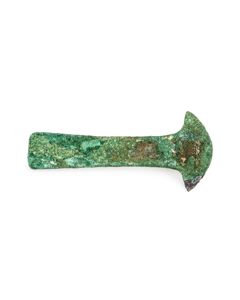 Ceremonial knife of the Sican culture
Ceremonial knife of the Sican cultureThe so-called Tumi was a weapon to cut the throats of humans and animals in ritual sacrifices. The knife certainly fulfilled an additional representative function in the afterlife. From the period of the Sican's cultural florescence during the 10th to 12th centuries AD.
Price: on request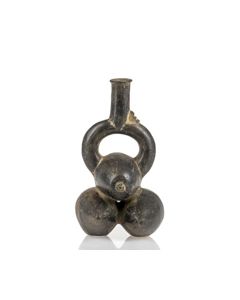 Stirrup vessel in the shape of cacao fruits
Stirrup vessel in the shape of cacao fruitsPlastically shaped vessel from the Peruvian Chimú culture. It embodies an important agricultural product of the pre-Columbian civilization of Chimor. With TL report from 1979. Part of a special exhibition from 2024 to 2025.
€1,600 Stirrup vessel as a water bird
Stirrup vessel as a water birdPlastically shaped vessel from the Peruvian Chimú culture, showing a water bird. From the 15th century. With TL report from 1979.
€910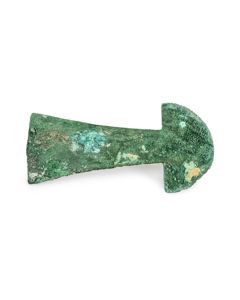 Large ceremonial knife of the Sican culture
Large ceremonial knife of the Sican cultureThe so-called Tumi was a weapon to cut the throats of humans and animals in ritual sacrifices. The knife certainly fulfilled an additional representative function in the afterlife. From the period of the Sican's cultural florescence during the 10th to 12th centuries AD.
€420 Gold figurine of a flute player from Panama
Gold figurine of a flute player from PanamaA fine gold work once worn as a pendant around the neck by an elite. The small male figure was made by a largely uniform Panamanian culture, right before the old crafts disappeared under the influence of the Spaniards.
€8,800

